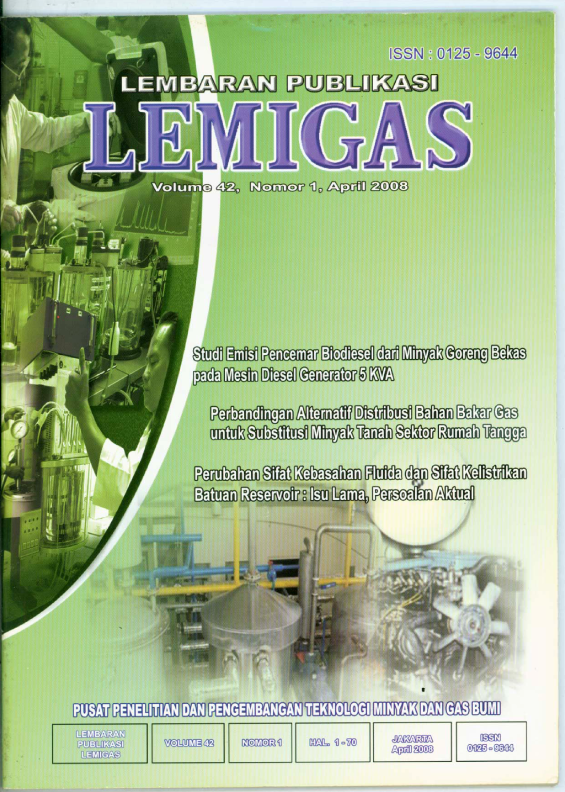Perubahan Sifat Kebasahan Fluida dan Sifat Kelistrikan Batuan Reservoir: Isu Lama, Persoalan Aktual
DOI:
https://doi.org/10.29017/LPMGB.42.1.83Kata Kunci:
sifat kebasaan, sifat kelistrikan, eksponen saturasi, temperatur, tekanan, saturasi air, kesalahan estimasiAbstrak
Eksponen saturasi (n) adalah salah satu parameter yang memainkan peran penting sekali dalam pengestimasian saturasi air dengan menggunakan data log sumur. Permasalahan yang telah diketahui secara meluas tetapi belum ditangani dengan optimum sampai sat ini adalah adanya perbedaan yang berarti antara data eksponen saturasi yang diukur pada kondisi atmosfer dan pada kondisi reservoir, akibat adanya perubahan sifat kebasahan (wettability) batuan, sedangkan fakta menunjukkan bahwa sebagian besar data tersebut diukur pada kondisi atmosfer. Artikel ini menyoroti kembali permasalahan lama yang masih tetap aktual ini dengan tujuan memperingatkan kembali pentingnya masalah ini. Penyebab-penyebab terjadinya perbedaan tersebut seperti perubahan sifat kebasahan, efek ekstrasi, efek cara pensaturasian, dan efek akibat kompresi dan pemanasan dibahas dengan cukup mendalam. Efek dari ketidakpastian dalam estimasi saturasi air akibat data eksponen saturasi yang tidak representatif juga disajikan secara grafis. Tulisan ini ditutup dengan diskusi mengenai kemungkinan-kemungkinan yang dapat diambil dalam meminimalisasi kemungkinan terjadinya perubahan sifat kebasahan batuan agar batuan percontoh yang hendak diukur di laboratorium memiliki sifat kebasahan yang merepresentasikan keadaan di reservoir.
Referensi
Anderson, W.G. “Effect of wettability on the electrical properties of porous media”. J. Pet. Tech., Desember, pp. 1371 – 1378.
Block, A. & Simms, B.B. (1967). “Desorption and exchange of absorbed octadecylamine and stearic acid on steel and glass”. J. Colloid and Interface Sci., Vol. 25, p.514.
Chilingarian,G.V. & Yen, T.F. (1983). “Some notes on wettability and relative permeabilities of carbonate rocks”. Energy Sources, Vol. 7, No. 1, pp. 67 – 75.
Cuiec, L.E. (1975). “Restoration of the natural state of core samples”. Soc. Petrol. Eng. Paper 5634, Annual Tech. Conf., Dallas, TX, Sept. 28 – Oct. 1.
Denekas, M.O., Mattax, C.C. & Davis, G.T. (1959). “ Effect of crude oil composition on rock wettability”. Trans AIME, Vol. 216, pp. 330 – 333.
Edmondson, T.A. (1965). “Effect of temperature on waterflooding”. J. Can. Petrol. Tech., Vol. 4, No. 4, Oct – Dec, pp. 236 – 242.
Emery, L.W., Mungan, N. & Nicholson, R.W. (1970). “Caustic slug injection in the Singleton field”. Soc. Petrol. Eng. JPT, Vol. 22, December, pp. 1569 – 1576.
Keller, G.V. (1953). “ Effect of wettability on the electrical resistivity of sands”. Oil & Gas j. Vol. 51, No.1, January, p. 65.
Lewis, M.G., Sharma, M.M. & Dunlap, H.F. (1988). “Wettability and stress effect saturation and cementation exponents”. SPWLA 29th Ann. Logging Symp., paper K, June 5 – 8.
Lo, H.Y. & Mungan, N. (1973). “Effect of temperature on water-oil relative permeability in oilwet and water-wet systems”. Soc. Petrol. Eng., Paper 4505, 48th Annual Conf., Las Vegas – NV, Sept 30 – Oct 3, 12 pp.
Longeron, D.G., Argaud, M.J. & Feraud, J.P. (1986) Effect of overburden pressure, nature, and microscopic distribution of the fluids on electrical properties of samples. Soc. Petrol. Eng. Paper 15383.
Lowe, A.C., Phillips, M.C. & Riddiford, A.C. (1973). “On the wettability of carbonate surfaces by oil and water”. J. Can. Petrol. Tech., vol: 12, No. 44, April – June, pp. 33 – 40.
Poston, S.W., Ysrael, S.C., Hossain, A.K.M.S., Montgomery, E.F. & Ramey, H.J., Jr. (1970). “The effect of temperature on irreducible water saturation and relative permeability of unconsolidated sands”. Soc. Petrol. Eng. J., Vol. 10, No.2, June, pp. 171 – 180.
Singhal, A.K. & Dranchuk, P.M. (1975). “Wettability control of glass beads”. Can. J. Chem. Eng., Vol. 53, February, pp. 3 – 8.
Sweeney, S.A. & Jennings, H.Y. (1960). “Effect of wettability on the electrical resistivity of carbonate rock from a petroleum reservoir”. J. Phys. Chem., Vol. 64, May, pp. 551 – 553.
Tiab, D. & Donaldson, E.C. (2004). “Petrophysics: Theory and practice of measuring reservoir rock and fluid transport properties”. Gulf Professional Publishing, 200 Wheeler Road, Burlington, MA 01803, USA, p. 889.
Treiber, L.E., Archer, D. & Owens, W.W. (1972). “A laboratory evaluation of the wettability of fifty oil producing reservoirs”. Soc. Petrol. Eng. J., Vol. 12, No. 6, December, pp. 531 – 540











